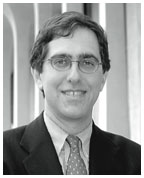Provost Christopher L. Eisgruber |
Christopher L. Eisgruber ’83, the Laurance S. Rockefeller Professor of Public Affairs in the Woodrow Wilson School and the University Center for Human Values, assumed the post of provost last July, having served with distinction as director of our Program in Law and Public Affairs. It is a joy to have Chris in Nassau Hall, and I am delighted to give him the floor today.—S.M.T.
Twice each year provosts from nine major research universities gather to discuss common problems. The group calls itself, accurately if unimaginatively, “The Nine Provosts.” I attended its meeting for the first time last October in New Haven.
Though the meeting emphasized shared issues, I was struck by one difference. As Princeton’s provost, I spend considerably more time focused on undergraduate education than do most of my counterparts at other major research universities.
Part of that difference, of course, is a matter of scale. At many research universities, concerns about professional schools—especially medical schools—consume much of the provost’s attention. Time not spent worrying about professional schools can be devoted to everything else, including under- graduate education.
But an equally important part of the difference is Princeton’s attitude toward undergraduate education. Many leading colleges and universities make a choice between research and teaching. Great liberal arts colleges tend to put teaching first and research second. Great research universities often put research first and undergraduate teaching second. Princeton insists on both.
Indeed, not only do we value both teaching and research, but we regard them as mutually reinforcing enterprises. Princeton’s community of learning is built around the conviction that the best teaching takes place when world-class researchers meet talented students to convey their knowledge of, and passion for, what is happening at the frontiers of human understanding.
Princeton’s commitment to teaching touches, in one way or another, the vast majority of issues that cross my desk. Thus when Yale’s new provost asked me about big initiatives at Princeton, the first things that came to mind were the expansion of the undergraduate student body and the creation of the four-year residential college program, including the construction of Whitman College.
Likewise, Princeton’s most exciting scholarly projects integrate research and teaching. For example:
• Professor David Botstein, the director of the Lewis-Sigler Institute for Integrative Genomics, has joined forces with colleagues from several departments to design a radical new science curriculum that simultaneously teaches freshmen and sophomores basic concepts and involves them in dynamic fields of ongoing research.
• Dean Maria Klawe’s vision for the future of the School of Engineering and Applied Science couples new interdisciplinary research ventures with curricular innovation.
• The University Center for Human Values annually sponsors several freshman seminars that bring together leading scholars and newly arrived students to study urgent issues in ethics, social policy, and the arts.
• In classrooms and laboratories alike, neuroscience is generating new collaborations at Princeton, ones that span not only departments but entire divisions of the University, bringing together natural scientists, engineers, social scientists, and humanists.
Princeton’s integrated research and teaching mission encompasses graduate as well as undergraduate education. Graduate students are intimately involved in research, and they participate in the classroom from both sides of the lectern, communicating their passion for scholarship to undergraduates through their teaching.
Princeton’s mixture of teaching and research is rewarding, but it is also resource-intensive. For example, Princeton holds its faculty to the same demanding research standards as do its peers and asks them to be exemplary teachers. The opportunity to teach splendid undergraduate and graduate students is an attraction for many of us on the faculty. But good teaching is not easy, even for those of us who love it. Princeton’s approach is not to every scholar’s liking, and it requires that we recruit a special faculty.
In various ways, the challenge of maintaining such a faculty is evolving and growing. First, the costs of doing first-rate scientific research have risen as experiments have become more sophisticated. Second, while the costs of research have increased, government funding for scientific research in many areas has remained flat or declined.
Third, there is more competition for the best scholars. Some universities, for example, have made strategic decisions to compete at the highest levels only in certain departments—in, say, philosophy, or in one particular subfield of physics. By focusing their resources on a small number of programs, these universities are able to attract scholars who might otherwise have gone to places with larger endowments or more established reputations. Princeton, on the other hand, aspires to be excellent in every field of study it pursues.
On the whole, this competition among universities is healthy. Princeton and other universities benefit from the existence of diverse centers of excellence. These institutions are collaborators as well as rivals, and they inspire us to improve current practices and rethink old assumptions.
Maintaining our high standing in the face of these challenges will require,
among other things, continuing creativity from those of us who steward
Princeton’s resources. That is what makes the job of provost at
Princeton so engaging. I am delighted to be able to undertake this project
in conjunction with President Shirley Tilghman and the fine team she has
assembled, and I am especially gratified to approach it on behalf of an
institution that has mattered greatly in my own life and for which I feel
tremendous affection. Education at its Best: The Fusion of Teaching and
Research “. . . not only do we value both teaching and research,
but we regard them as mutually reinforcing enterprises.”
![]()


